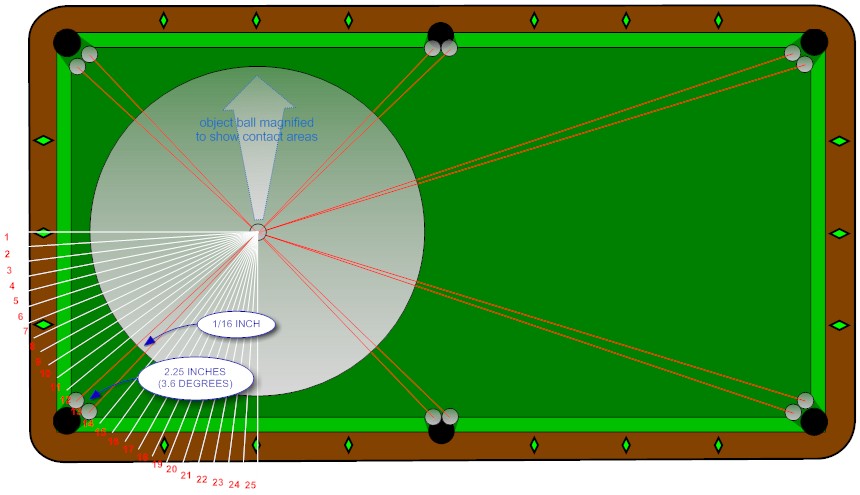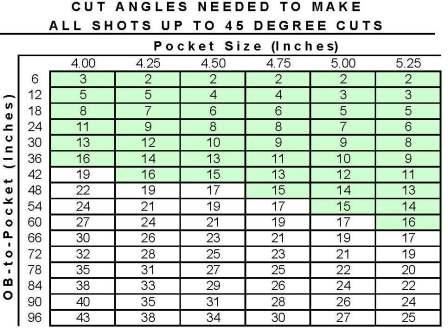How many lines or alignments of aim are required to pocket a typical range of shots?
Many “aiming systems” use a limited set of alignments or lines of aim that can get you close to the right aim for a wide range of shots. However, a limited number of aims is not sufficient for a typical range of shots, unless aiming adjustments are made relative to these fixed references.
For a given shot, with N different lines of aim, assuming you can hit where you are aiming, the object ball can go only in N different directions. Depending on where a pocket is and how far it is from the object ball, the cut shot may or may not be make-able with one of the selected aiming lines.
Even with english effects (squirt, curve, and throw), the object ball can still go only in N different directions for N lines of aim for a given cue stick elevation and shot speed, and for given ball and table conditions.
See TP A.13 for background and specific results. Here are some highlights:
- To be able to pocket an object ball into a “large” pocket about 3 feet away, with an average angle to the pocket, and for any cut angle, the required number of aiming lines is about 19!
- If you consider cut shots only within a typical range (e.g., 7.5 to 52.5°), and use only three equally spaced lines of aim (e.g., the 15, 30, and 45° aims):
- If the object ball is less than a foot from the pocket, every shot can be pocketed with the three lines of aim.
- If the object ball is more than two feet from the pocket, less than 50% of all cut shots in the limited range can be pocketed with only three lines of aim.
Now, fixed-reference aiming systems can still be useful to some people, based on the benefits listed here. The systems can provide a good “framework” from which to work, especially for people that have difficulty aiming accurately and consistently.
from Bob Jewett (in AZB post):
One aiming method is to imagine the 2-D overlap of the cue ball as it lands on the object ball and connect the amount of overlap to the cut angle. The common fractions and their approximate degrees of cut are:
full ball — 0 degrees — straight shot
3/4 full — 15 degrees
1/2 full — 30 degrees
1/4 full — 45 degrees
1/8 full — 60 degreesExcept for the half-ball hit which is 1/2 full and a cut of 30 degrees, those numbers are all slightly off, but the errors are not important for this first part of the discussion. Another factor that must eventually be considered is throw which varies with the speed and spin of the cue ball but that gets very complicated and it is better to completely understand the simple fundamental ideas of the situation before we get into all the nasty details. Those details are important and we’ll get to them.
![CropperCapture[193].jpg CropperCapture[193].jpg](https://billiards.colostate.edu/images/Bob_fractional_limitations.jpg)
In the diagram you see a shot off the spot and five different areas where the five fractional aims will be useful. Let’s consider the straight shot or 0 degree cut. How wide is that area? The pocket is two balls wide (more or less) and the two extreme arrival positions of the object ball are shown by the 2 ball and the 3 ball. If you draw straight lines from the centers of those balls back to the 1 ball, you get the angular width of the pocket. It is about 4 degrees. If the object ball is sent more than 2 degrees away from dead center of the pocket, it won’t go in. (Again, this is not perfectly accurate. From this approach angle, the pocket is larger for very hard shots, so the pocket size varies with the shot conditions. Pick your own number if you don’t like 4 degrees of pocket width.)
Where can the cue ball be in order to pocket a straight shot to that pocket off the spot? It is pretty obviously the red shaded area marked “0°”. If the cue ball is anywhere on the bottom/right side of the shaded area, with a perfect, full hit the object ball will pass over the position of the 2 ball. If the cue ball starts on the top/left side of the shaded area the cue ball will pass over the position of the 3 ball. If the cue ball is anywhere outside the red shaded area, a full hit won’t pocket the object ball.
The same argument applies to the other standard fractional cuts. It is not hard to see that all the triangular areas for the different cuts are 4 degrees wide. This means that the standard fractional cuts for a shot as hard as a spot shot cover only about 1/4 of the area of the table. The “good” triangles are 4 degrees wide and 15 degrees apart.
But it is a really, really bad idea to wed yourself to exact fractional ball hits. Just consider the straight shot. If the cue ball is on one edge of the red shaded area, and you use a true fractional aim, you will send the 1 ball all the way to the extreme side of the pocket. If your stroke makes a small error in that same direction, you will miss the shot. Since most of us make small errors most of the time (and large errors the rest of the time), you will end up missing about half of such shots.
The lesson from this is that the “good” triangular areas for the shot are actually considerably smaller. If you are willing to give up half of the allowed error to your aiming system, then the triangles will shrink to 2 degrees wide and the percent of the table that is covered by these fractional aims drops by a factor of two to roughly 1/8th or 12.5% of the table surface.
from Patrick Johnson:
[The diagram below] shows that to make a spot shot from anywhere on the table into a 4.5″ pocket takes ~25 discrete cut angles per quarter ball (per cut direction), each ~3.6° wide (contact area ~1/16″ on OB’s surface).

What does this mean?
If the OB is left in place and the CB is moved around it in an arc, the cut angle needed to make the shot changes. If the pocket was exactly as wide as a ball, then the cut angle would have to change with every infinitesimal movement of the CB and it would take an infinite number of cut angles to make shots from all possible CB positions. But with a 2.25″ margin of error in the pocket, the cut angle only needs to change with every 3.6° movement of the CB (25 times as the CB moves through a 90° arc for all the cuts in one direction).
This is why it is often said that any system must define more than a handful of cut angles in order to work “without adjustment”. For example, if a system defines only 6 cut angles for each cut direction, then the system by itself can only make 6/25 (~1/4) of all possible spot shots into a 4.5″ pocket, and the other 3/4 of all possible cut angles are in the gaps between the 6 system-defined cut angles.
from Patrick Johnson:
It takes 15 aim points to make any shot on the long string near the pocket (ignoring some space at the top of the string to put a cue ball) – more on strings farther away. The drawing below shows how this is true, but it may take some staring and scratching to understand.
Each two contiguous balls (and any ball between them) can be made in the upper right corner pocket (5″ wide) with the same cut angle. Each ball can be made with the cut angle of both balls contiguous to it. So they show when the angle must change and the maximum it can change without leaving any OBs that can’t be made.
For illustration, the common cut angle for each of the first two pairs of balls is shown by parallel lines of matched color (red or white) – these lines show that both balls will fit between the pocket points using the same cut angle. By cheating the pocket the maximum amount one way or the other, the second ball can be made using either cut angle #1 (cheating the pocket to the right) or cut angle #2 (cheating the pocket to the left) – this dictates the change in cut angle from #1 to #2, ensuring there are no gaps between OBs that can be made.

from Patrick Johnson:
Here’s a chart showing the minimum number of aim points within 1/8 of a ball circumference (up to 45° of cut angle, or half of all possible shots).

The green-shaded boxes show which combinations of pocket size and OB-pocket distance work with 15 or fewer aim points. For average size pockets (4.5 to 5.0 inches) you need more aim points when you get beyond about 4 feet from the pocket. So your estimate that “any typical shot” works is overstated, but not ridiculous. With a real aiming system, we have to double the number of aim points – an aiming system would have to have a minimum of 30 total aim points per side (left or right cut) for half of them to cover most “typical” shots.
Dr. Dave keeps this site commercial free, with no ads. If you appreciate the free resources, please consider making a one-time or monthly donation to show your support:
